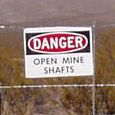
MSHA to Public: 'Stay Out and Stay Alive'
The U.S. Department of Labor's Mine Safety and Health Administration yesterday kicked off its annual "Stay Out--Stay Alive" public safety campaign to warn outdoor enthusiasts--especially children--about the dangers of playing on mine property. Each year, dozens of people are seriously injured in recreational accidents at abandoned and active mine operations across the country. Since 1999, more than 200 people have died in such accidents, 148 of which occurred over the past five years. So far this calendar year, MSHA has recorded at least eight known deaths on mining properties¬.
"As we near the end of another school year, we need to stress to people of all ages that playing in or exploring mines and quarries can be dangerous," said Richard E. Stickler, MSHA's acting assistant secretary. "Abandoned and active mines contain hazards that can be deadly for those not properly trained in safe mining practices, and that's why it's best to 'Stay Out and Stay Alive.'"
Stickler helped launch the campaign yesterday in Bruceton, Pa., where he addressed a group of school-age children, then led them on a mine tour at the National Institute for Occupational Safety and Health's research center. MSHA first launched "Stay Out--Stay Alive" in 1999. The campaign is a partnership of more than 70 federal and state agencies, private organizations, businesses, and individuals. During the month-long campaign, which runs May 12 through June 13, federal mine safety and health professionals will visit schools, scouting groups, and other venues to talk to young people about the dangers of playing on mine property. MSHA will place a special emphasis on reaching males 15 to 25 years old, the age group which accounts for the majority of recreational mine-related accidents and deaths.
There are about 500,000 abandoned mines and another 14,000 active operations throughout the United States. Mines are located in every state--from small sand and gravel operations to complex underground coal, salt, limestone, or metal mines. As cities and towns spread into the surrounding countryside and more people visit these remote locations, the possibility of contact with an active or abandoned mine increases, MSHA says.
Underground abandoned mines may harbor hidden shafts, decayed and rotting boards, tunnels prone to deadly gases and flooding, and unused or misfired explosives. Water-filled quarries may contain unstable rock ledges, concealed machinery and sharp objects, and dangerously cold and deceptive waters. For an electronic press kit, visit MSHA's Web site at www.msha.gov and click on "Newsroom."